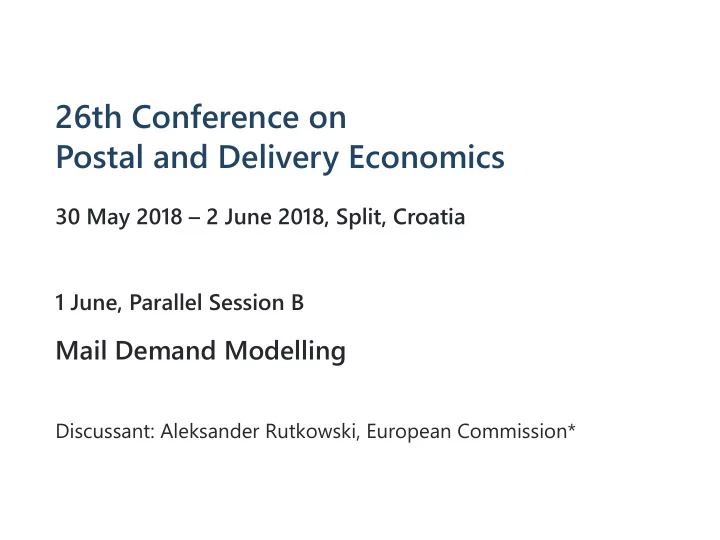

26th Conference on Postal and Delivery Economics 30 May 2018 – 2 June 2018, Split, Croatia 1 June, Parallel Session B Mail Demand Modelling Discussant: Aleksander Rutkowski, European Commission*
Disclaimer * The views expressed in my talk and slides are my own and may not, under any circumstances, be interpreted as stating an official postion of the European Commission. 2
Who I am Member of the Chief Economist Team in Directorate-General for "Internal Market, Industry, Entrepreneurship and SMEs" (DG GROW, unit 01). Supports our operational unit (E2) in the compilation of postal statistics inherited from Eurostat (validation, merging with auxiliary Eurostat data and calculation of policy indicators, export for official publication, etc.; first developed Stata as command line scripts, now R/Shiny server app with 3K+ lines of code, home-brewed R libraries not included). https://github.com/alekrutkowski 3
Comments on all the papers Meticulous hard work Similar tendency: use pre-defined model/method to obtain disaggregated results , always appreciated It would be useful to see even more policy recommendations (inspired by the findings) for: national postal regulators, industrial and competition policy-makers, or the European regulators/legislators 4
POSTAL VOLUMES, BUSINESS CYCLE, AND INTEGRAL EQUATIONS 5
Questions on 1st & 2nd papers, Clendenin et al., Pearsall Postal indicators in the US related only weakly to business cycle? Consistent with the literature? Not discussed. Why no control / other explanatory variables? Risk of omitted variable(s)? Much stronger link with volume than revenue (per piece). Simplest explanation – regulated/sticky prices – insufficient? Is really worksharing as cyclical as GDP (see the next slide)? Worksharing absent in periodicals? (#1, p. 16) 6
Questions on 1st & 2nd papers, Clendenin et al., Pearsall (cont.) US postal worksharing intensity vs US real GDP growth 7
Questions on 1st & 2nd papers, Clendenin et al., Pearsall (cont.) The results depend fundamentally on the HP-filter , which is repetitively criticised , e.g. most recently Hamilton, 2017: despite its popularity, the HP filter has serious drawbacks that should severely restrict its application . It involves several levels of differencing, so that for random walk series, subsequently observed patterns are likely to be artefacts of having applied the filter, rather than due to the underlying data-generating process . ∙ Could other more robust cycle extraction methods be considered (other filters, fundamental/structural models etc.)? ∙ A perfect case for cointegration analysis? (Vahif & Engle, 1993, "Common Trends and Common Cycles"; Engle & Issler, 1995, "Estimating Common Sectoral Cycles") 8
Questions on 1st & 2nd papers, Clendenin et al., Pearsall (cont.) ∙ Sometimes difficult economic interpretation , e.g.: Altogther, the response of postal revenue to the business cycle is statistically insignificant . ... The effect of the business cycle on real postal revenue is almost entirely a timing phenomenon ... The symmetry test ... is significant So real postal revenue lags the business cycle . (#1, p. 13) ⇒ omitted variable? ∙ Shouldn't the volume and the revenue (per piece) equations be estimated jointly as a system (e.g. SUR/VAR)? They are interlinked via e.g. worksharing (as explained in the paper). 9
Questions on 1st & 2nd papers, Clendenin et al., Pearsall (cont.) ±18 month period: too short to capture the full cycle? For 1945–2009, the NBER reports the average cycle duration 1 (trough – previous trough or peak – prev. peak) of a bit over 5 2 years (i.e. almost 2 x longer). http://www.nber.org/cycles.html Local fits : 37 observations with 6th-power polynomials ⇒ overfitting? How do they differ from or outdo LO(W)ESS, (kernel-weighted) local polynomial smoothing, or regression splines? GDP deflator a good proxy for postal prices? = correlating nominal GDP with nominal postal revenues? no good postal-sector cost-based deflator (e.g. wages)? 10
Questions on 1st & 2nd papers, Clendenin et al., Pearsall (cont.) #2, section 4, p. 9: Why P ( u ) and not P ( u , v ) ? v ∈ [0, 1] ? #2, section 6, p. 12: 2 16 ] Why 16 in [ 1 u u ... u ? #2, section 8, p. 18: What are the definitions of u and v here? 11
E-SUBSTITUTION AND ITS DRIVERS 12
Questions on 3rd paper, Cazals et al. Survey based: self-reporting biases ? Any cross-validation checks? Why population instead of households used to proxy delivery point growth (departure from Veruete-McKay)? Why only one observation per j , k , l "cell" (p. 5)? No access to the raw/micro data of the survey? How many levels ( J , K , L ) are in each factor? How are they distributed in the survey data? Weighted ANOVA ⇒ "factors and their interactions are no longer orthogonal" (p. 6) ⇒ risk of multicollinearity , checked? 2 (Very high R may indicate it). 13
Questions on 3rd paper, Cazals et al. (cont.) Statistical and economic significance : have you checked the latter too? Regression with dummies could provide economically- interpretable coefficients for each level of each factor. That would be a formal statistical test of what Section 4 (pp. 8–9) does informally. 14
Questions on 3rd paper, Cazals et al. (cont.) Why separate decompositions for 2009, 2012, 2016 and not a joint (panel) estimation across all the available years? Linear time trends could be tested through the interactions with the time variable (year number). Common cycle and non-linear developments could be tested with time as a factor (time dummies). It would allow for eliminating the impact of time-invariant characteristics ("fixed effect") or even varying but random obervation-level indiosyncarcies ("random effect"). 15
Recommend
More recommend